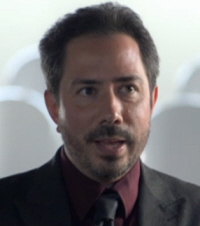Dark Matter
The Hidden Universe
Horizon - How BIG is the Universe?
2D Universe
The Sloan survey is one of the great achievements of Precision Cosmology. Red shift measures the distance – the third and final coordinate for every
galaxy… To make a 3-D movie on a colossal scale.
David Schlegel "Maybe you've seen things like this in the opening of Star Trek or Star Wars or whatever, and that all looks great, but it's not
real. This movie – it is the real universe."
Every point of light on the map is a galaxy like the Milky Way. Cosmologists can now see at a glance how the galaxies are arranged in space.
David Schlegel "What these maps let us do, is it really allows us to test all the forces of nature we know about. There is structure, really, on all scales."
The galaxies are not just placed at random – they are bound together by gravity, in a vast cosmic web.
David Schlegel "This goes on and on, and in fact up to the largest scales that we can see. You can still trace the structures of galaxies."
But the most surprising discovery is what can't be seen. Most of the universe is missing.
Anthony Aguirre "The gravity, due to the stuff that we see, due to say the galaxies and stars, can't do the job. It's simply not enough
stuff to arrange things into the patterns that we see, have galaxies spinning in a way that they do. There's something else that's there. There
is something beyond the galaxies that we see, the visible matter. There's some sort of Dark Matter out there."

Anthony Aguirre
Modern cosmology needs a new kind of mapmaker. Because most of the universe is hiding in the dark. We don't know what Dark Matter is because it's
never been detected on Earth. We know it must be out there, because it's gravity is holding the cosmic web of galaxies together. But we can't see it,
because it doesn't give off light. Someone has to find it and put it on the map.
Richard Massey
British astronomer Richard Massey is a master of the invisible. He is a member of the team hunting for Dark Matter, based at the California
Institute of Technology. So, he is a frequent flyer to the city of Los Angeles.
Richard Massey "When you're flying across America, at night, you see these criss-crossing lanes of streetlights spread out across the continent.
There is obviously some interesting stories going on down there, in between these roads. In fact, most of the story of what's going on in America is
actually happening in those empty spaces that you can't see."
Richards task is like mapping those apparently empty spaces. It's as if whole cities were hiding in the dark.
Richard Massey "If we're driving across America, and trying to map out a new frontier, can see mountains and valleys and streams and we can
draw them all on a map. But when we're trying to map out the universe, most of its contents are invisible."
It takes imagination to find your way in a Dark Universe. You have to dream up new ways to detect what can't be seen. One possibility is that
if Dark Matter doesn't give off light maybe it absorbs light.
Richard Massey "Ordinary matter, stuff that we are made out of, casts a shadow – because it absorbs light. So we can see the ordinary matter in silhouette. "
Unfortunately, Dark Matter doesn't give itself away that easily. Light just goes straight through it.
Richard Massey "Dark Matter doesn't interact with light in any way, so we can't look for a silhouette to map out where it is. We have to be a
bit more ingenious about it."
Bent Legs
The solution depends on a very simple idea. It's like looking at lights in a swimming pool.
Richard Massey "The secret to mapping Dark Matter that you can't see, is to look at the light that you can see. Everything that has mass,
including Dark Matter, actually bends the fabric of space and time that we live in. And if space is warped, then everything in it is distorted.
Even the paths of light rays."
The only way that Dark Matter might reveal itself is through gravity. According to Einstein's Theory of Relativity, all matter distorts space
causing the light to change direction.
Richard Massey "The idea of General Relativity bending space and time and deflecting rays of light sounds complicated. But actually you see
light rays bending all the time. When you look into a swimming pool and see your legs aren't in the right shape, you know that there must be
some water in the way."
Hubble Space Telescope
The distortion of the lights depends on water ripples in the pool. Which in turn depend on where the swimmers are at any one moment.
This is great, we're seeing these distorted images of lights under the pool and by looking at the shapes of these, we can work out what the
ripples in the water are doing.
The survey team went looking for Dark Matter in exactly the same way… With 1,000 hours of observations on the Hubble Space Telescope.
Richard Massey "By looking at distant galaxies halfway across the universe, by looking at their shapes and the distorted images that we see
of those, we can work out what ripples there are in space between them and us. And those ripples in space are caused by the Dark Matter."
The search zone was a thin column of the universe, stretching 8 billion light years from Earth. The team were on the look-out for distortions in
the most distant galaxies.
Richard Massey "Whenever you see galaxies distorted into the strange uncharacteristic shapes, you know that there must be something in between
them and you, something really massive, and even if it's invisible, you can still map out where it is by the way it warps that space time."
Einstein Ring
The mapping technique revealed a ghostly, hidden universe. The light from visible galaxies was re-cast in new and beautiful forms.
Richard Massey "They've become these full rings, distorted just like what are known as Einstein Rings, whenever there's a big lump of Dark Matter in
front of them."
The lumps become contours on a map of the invisible. They reveal dark matter as the hidden iceberg beneath the surface of the cosmic ocean.
Richard Massey "What we're finding out there in the universe is really weird. It's equivalent to the idea that only one out of six cities
in America actually has any people living in it. The other five sixths of the population are these invisible ghosts that we just can't see."

Janna Levin
The survey has transformed the map of the universe. It suggests that normal, visible matter is just a fraction of what's out there. In the
search zone, Dark Matter outweighs it by 6 to 1. This is the stuff the universe is really made of. For cosmologists, the road ahead has become
a lot less certain. Right now, we know the universe is expanding. But given enough Dark Matter, it could have a different, and very dark future.
Janna Levin "It's sensible to conclude when we look at how that stuff affects the shape of space, the universe should not be expanding but
that it should be slowing down."
Dark matter puts a very heavy foot on the brakes. Because the more matter there is, the more gravity there is.
Anthony Aguirre "Gravity attracts. And so the cosmic expansion should be slowed down by all that attraction."
If there's enough Dark Matter, the universe will eventually stop expanding altogether… And go into reverse. Gravity will bring everything back
together, in a final, cataclysmic big crunch. The question is – when?

